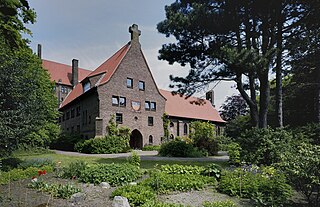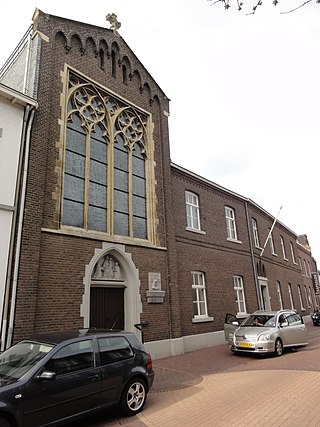
Trappist beer is brewed by Trappist monks. Thirteen Trappist monasteries—six in Belgium, two in the Netherlands, and one each in Austria, Italy, England, France, and Spain— produce beer, but the Authentic Trappist Product label is assigned by the International Trappist Association (ITA) to just ten breweries that meet their strict criteria. As of 2021, Achel is no longer recognized as a Trappist brewery because it does not have any monks.

Susteren Abbey is a former Benedictine abbey at Susteren near Roermond, in the Dutch province of Limburg, founded in the 8th century. The former abbey church is now St. Amelberga's Basilica.

Echt is a city in the Dutch municipality of Echt-Susteren in the province of Limburg, Netherlands. It was a municipality itself until it merged with the municipality of Susteren on 1 January 2003.
Westmalle Abbey, otherwise the Trappist Abbey of Westmalle, is a monastery of the Cistercians of Strict Observance in Westmalle in the Belgian province of Antwerp.

St. Sixtus' Abbey, Westvleteren, which belongs to the Cistercians of Strict Observance, or Trappists, is a Roman Catholic abbey located in Westvleteren, in the Belgian Province of West Flanders. The abbey is famous for its spiritual life, characterised by prayer, reading, and manual work, the three basic elements of Trappist life. It has also a reputation for its brewery, one of several producers of Trappist beer in Belgium.

The Trappist Abbey of Achel or Saint Benedictus-Abbey or Achelse Kluis, which belongs to the Cistercians of Strict Observance, is located in Achel in the Campine region of the province of Limburg. The abbey was famous for its spiritual life and its brewery, which was one of only a few Trappist beer breweries in the world. Life in the abbey was characterised by prayer, reading and manual work, the three basic elements of Trappist life. The monastic community came to an end in January 2021, with the last two monks moving to Westmalle Abbey.

Brecht Abbey, also known as the Abbey of Our Lady of Nazareth, is an abbey of Trappistine nuns located in Brecht, in the Campine region of the province of Antwerp. Life in the abbey is characterized by prayer, reading and manual work, the three basic elements of Trappist life.

Egmond Abbey or St. Adalbert's Abbey is a Benedictine monastery of the Congregation of the Annunciation, situated in Egmond-Binnen, in the municipality of Bergen, in the Dutch province of North Holland. Founded in 920-925, and destroyed during the Reformation, it was re-founded in 1935 as the present Sint-Adelbertabdij, in the Diocese of Haarlem.

Herkenrode Abbey was a Catholic monastery of Cistercian nuns located in Kuringen, part of the municipality of Hasselt, which lies in the province of Limburg, Belgium.

Drongen Abbey, or the Old Abbey, Drongen, is a monastic complex on the River Leie in Drongen, a part of the city of Ghent in East Flanders, Belgium.

Male Castle, Bruges. A community of the Canonesses Regular of the Holy Sepulchre. It originated in Bruges in the 11th century, and between 1954 and 2013 was settled in Male Castle in Male, Sint-Kruis, Bruges, West Flanders, Belgium.

Aduard Abbey is a former Cistercian abbey in the village of Aduard about 8 kilometres to the north-west of Groningen in the Netherlands, founded in 1192 and dissolved in 1580.
Sibculo Abbey, also called Groot Galilea, was a Cistercian abbey founded in 1403 by followers of the Modern Devotion movement and dissolved in 1579 during the Protestant Reformation of the Netherlands. Its remains are near the village of Sibculo in the municipality of Hardenberg in Overijssel.

Koningshoeven Abbey is a monastery of the Trappists founded in 1881 in Berkel-Enschot in North Brabant, the Netherlands.

St. Benedictusberg Abbey, also Mamelis Abbey, is a Benedictine monastery established in 1922 in Mamelis, a hamlet which administratively falls within Vaals, Netherlands. It is a rijksmonument.

Ten Duinen Abbey or the Abbey of the Dunes was a Cistercian monastery at Koksijde in what is now Belgium. It was one of the richest and most influential religious institutions in the medieval County of Flanders. It later relocated from Koksijde to the city of Bruges.

Ulingsheide Abbey was a Trappist monastery in Tegelen, Venlo, the Netherlands, very close to the Dutch border with Germany. It was founded in 1884 as a daughter house of Westmalle Abbey in Belgium, to receive German novices in the wake of the Kulturkampf. The community was merged to that of Lilbosch Abbey in 2002, the house becoming an annex of Lilbosch. As of summer 2020 negotiations were ongoing for the sale of the property to developers.

Pepinusbrug is a hamlet south-east of Pey in the Dutch municipality Echt-Susteren.

The Carmelite Monastery in Echt, in the province of Limburg, the Netherlands, also known as the Echt Carmel, is a community of Discalced Carmelite nuns established in 1879.






















